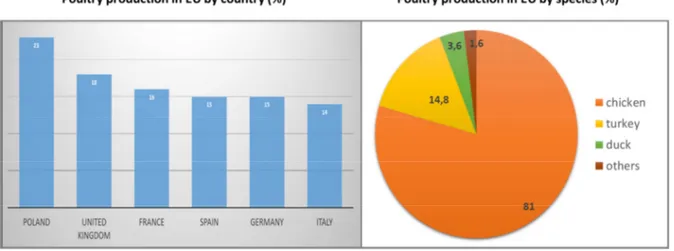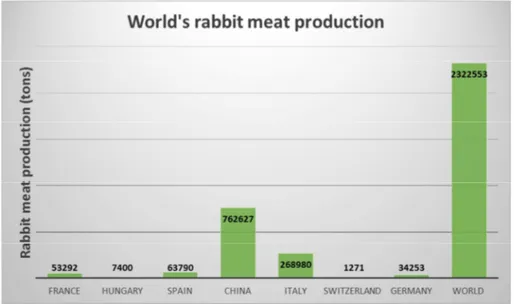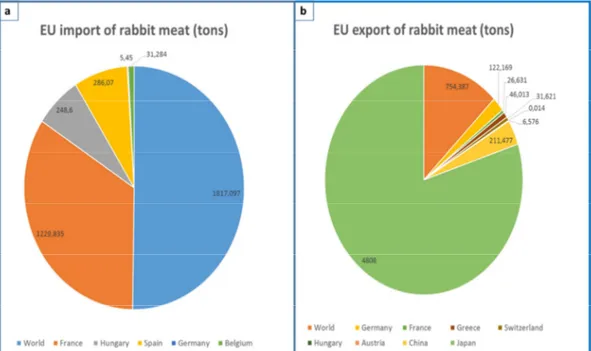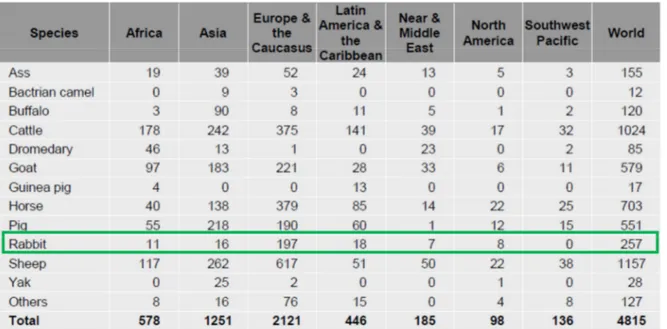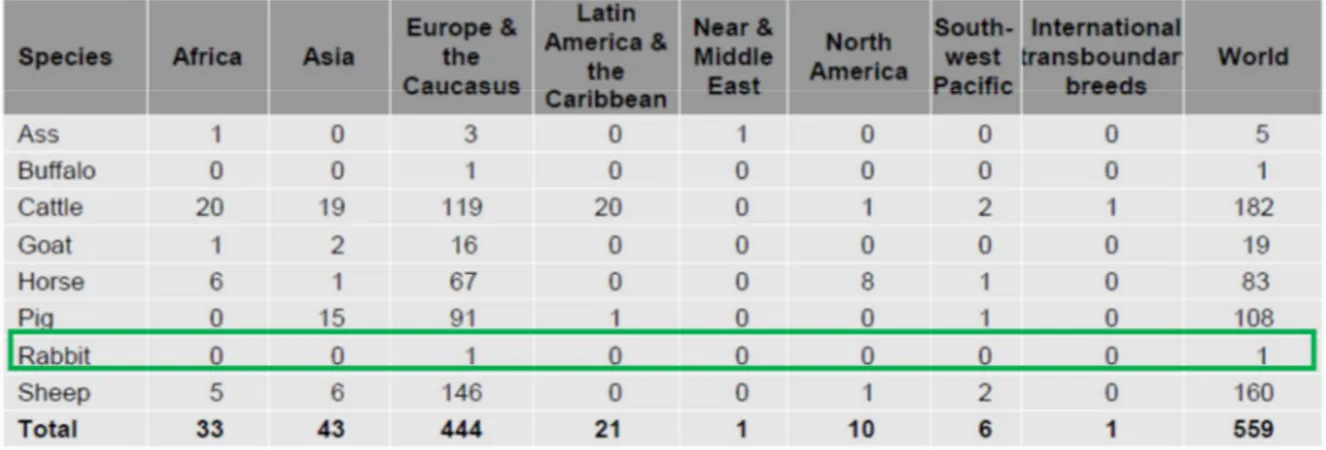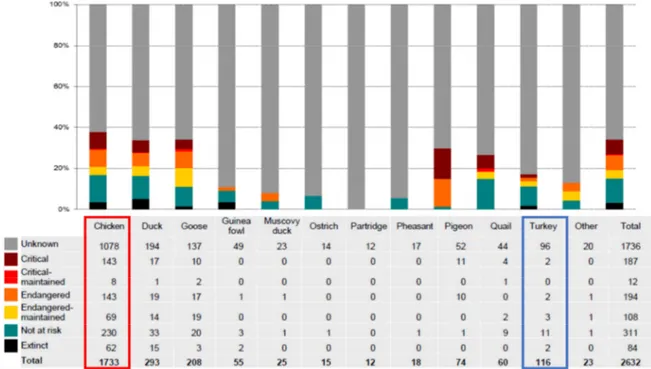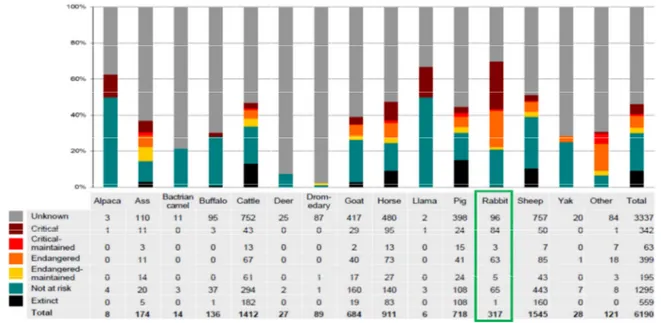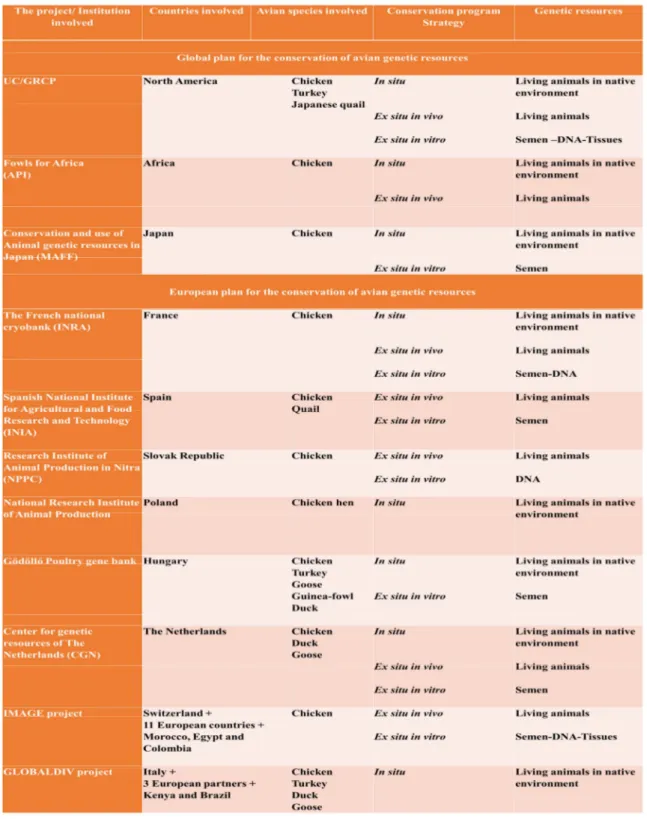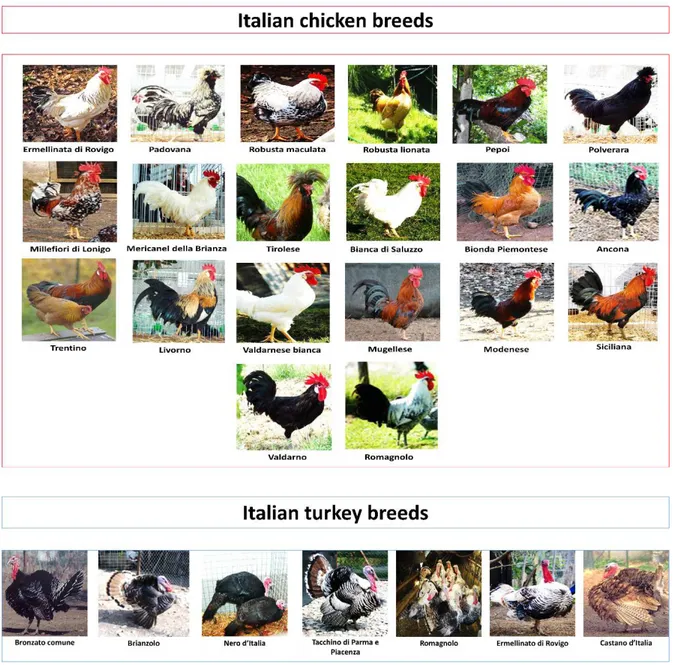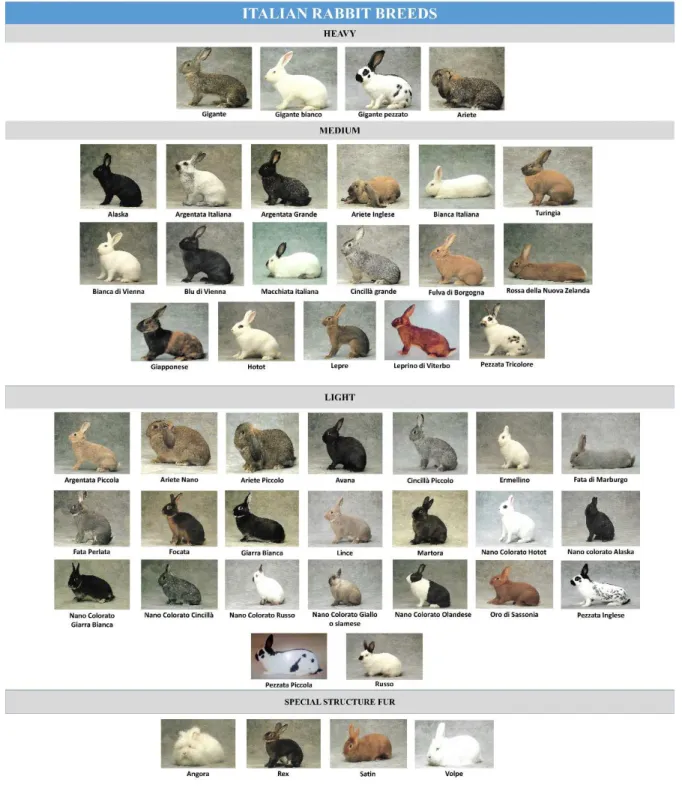UNIVERSITÀ DEGLI STUDI DEL MOLISE
Department of Agricultural, Environmental and Food Sciences
International Ph.D Course in:
AGRICULTURE
TECHNOLOGY
AND
BIOTECHNOLOGY
(CURRICULUM: Welfare, biotechnology and quality of animal production)
(C
YCLE
XXX)
Related disciplinary scientific section: AGR/20 (Zoocolture)
PhD thesis
Semen cryopreservation as a tool for preserving
genetic biodiversity of avian and rabbit species:
national cryobank launch
Coordinator of the Ph.D Course: Prof. Giuseppe Maiorano
Supervisor: Ph.D candidate:
Prof. Nicolaia Iaffaldano Marsia Miranda-153768
I
INTRODUCTION
The conservation of genetic diversity in livestock species can be related to biological, social, cultural and economic aspects. Animal genetic resources and animal management systems are an integral part of ecosystems and productive landscape in Italy, Europe and all over the world. Local breeds can be considered as a part of the history of some human populations as well as important materials from a scientific point of view. To date there is an urgent need of a specific conservation program for these breeds because of the limited number of their individuals and their risk of extinction. Although the local breeds are usually not competitive for production traits, they may carry valuable features such as disease resistance or distinctive product quality. The higher economic value of typical productions compared to conventional commercial products and the growing consumer preferences towards food quality, could strongly support the need to launch conservation programs of livestock biodiversity. In this regard, efficient in situ and ex situ conservation strategies are obligatory tools in order to implement an appropriate action for the conservation of livestock biodiversity. Conservation of genetic diversity across and within farm animal breeds is an insurance for the future. A broad genetic base is crucial to deal with future changes in environment, consumers demand for animal products and animal production systems. A wide genetic variation is also a safeguard against sanitary outbreak and natural disasters, in the maintenance of agro-ecosystem diversity and conservation of rural cultural diversity. The conservation of livestock variability is also a crucial element in order to preserve and valorize specific nutritional and nutraceutical properties of animal products.
In situ conservation strategies are effective in reaching all these objectives except for the safeguard against emerging diseases, political instability and natural disaster. In contrast, ex situ conservation strategy is the method of choice to safeguard farm Animal Genetic Resources (AnGRs) against natural calamities and it is a valuable option when socio-economic, cultural and ecological values linked to a breed, are missing or of no interest. Therefore, the field of ex situ conservation is getting more attention with its wider application in the field of AnGRs management and conservation. To this aim, the cryopreservation technique is commonly used in the storage of genetic resources including oocytes, embryos, somatic cells, primordial germ cells (PGCs) and sperm. This technique offers important opportunities for the conservation and utilization of farm animal genetic
II
resources by the creation of a cryobank supported by government, institutional breeding organizations and private breeders.
Some European countries such as France, The Netherlands and others, outside of Europe such as America and Japan, have been involved in specific conservation programs for AnGRs and include poultry (e.g. chicken and turkey) and rabbit breeds.
Currently also in Italy there is an urgent need of national actions aiming at specific conservation programs for Italian poultry and rabbit breeds because of the limited number of their individuals becoming in risk of extinction. In the light of this, conservation and valorization projects of Italian poultry and rabbit breeds have been developing thanks to the financial support of regional and local public institutions. These projects are only based on the in situ conservation strategy. While recognizing that in situ strategy is a priority, the ideal conservation plan should consist in the integration of both strategies, in situ and ex situ (FAO, 2008; FAO, 2012). Regarding the ex situ in vitro technique, the semen cryopreservation represents a valuable tool to safeguard the genetic animal resources by cryobanks. This technology becomes particularly precious in poultry species for the reason that the semen cryopreservation in this species is the only reproductive procedure currently available because of the unique biological features of birds and in rabbit because cryopreserving sperm is easier and cheaper than obtaining embryos (Mocè and Vicente, 2009).
In this regard, the present doctoral thesis aims at the identification of reference procedures for the cryopreservation of poultry (turkey and chicken) and rabbit semen according to the “FAO guidelines - Cryoconservation of animal genetic resources” (2012).
The reference procedures will be implemented for the constitution of a sperm cryobank of Italian, turkey, chicken and rabbit breeds, that are not available at national level right now. The following specific aims of the present doctoral thesis are reported in short below: 1. improvement of the cryopreservation success of both turkey (study 1) and chicken
(study 2) semen packaged into straws;
2. development of effective protocol for rabbit semen (study 3) in order to reduce cryoinjuries during the freezing procedure and improve the sperm integrity after freezing/thawing
III
IV
AKNOWLEDGEMENT
The realization of this thesis was only possible due to the several people's collaboration, to which I desire to express my gratefulness.
I would like to express my deepest gratitude to my supervisor, Prof. Nicolaia Iaffaldano for her guidance, patience, motivation, and support.
I would like to express my gratitude to Dr. Michele Di Iorio for his help, encouragement, teaching and advice.
I would like to thank also my Slovak advisor Prof. Peter Chrenek for giving me the possibility to work in his laboratory, at the Animal Production Research Centre (NPPC Nitra) and his collaborators Dr. Barbora Kulíková, Dr. VašíčekYaromir and Dr. Andrej Baláži.
I would like to thank the General Coordinator Prof. Giuseppe Maiorano for his accurate organization of the Ph.D. course.
Many thanks to the president Dr. Michele Schiavitto of Italian National Rabbit Breeders (ANCI-AIA) for allowing me to use the Central Breeding Farm. I also thank Drs. Paola Principe for the technical assistance with semen collection and artificial insemination.
I would like to thank also Prof. Luca Romagnoli for help with the statistical analysis of data, and Amber Burchell and Francesca Di Nezza for the English revision.
Moreover, I would like also to thank all my PhD colleagues. I also thank all my friends, who supported me during these years.
Finally, but not the least, I would like to thank my family, for their love, constant support and encouragement.
V
EVALUATION REPORT OF DOCTORAL THESIS
Title of the thesis
Semen cryopreservation as a tool for preserving genetic biodiversity of avian and rabbit species: national cryobank launch
Name of the PhD candidate Marsia Miranda
Name and affiliation of the thesis supervisor
NICOLAIA IAFFALDANO – University of Molise
Name and affiliation of the referee
PETER MASSANYI – Slovak University of Agriculture in Nitra, Slovak Republic
Evaluation:
Overall clarity and organization of the thesis
Outstanding Very good Good Sufficient Poor
Clarity ☒ ☐ ☐ ☐ ☐
Organization ☒ ☐ ☐ ☐ ☐
Comments:
Generally the submitted PhD. thesis is very well prepared, all parts are clear and the overall impression is very positive.
There are only some minor typo and grammar errors.
I has to be state that this PhD. thesis of a very good quality, the review is very well prepared, aim of the study are clear and real, all methods are acceptable and giving significant results. The role of supervisor and coordinator of the course (thesis) should be very highly appreciated.
Clarity of the Objectives
Outstanding Very good Good Sufficient Poor
☒ ☐ ☐ ☐ ☐
Comments:
Objectives of the PhD. thesis are clearly established, very actual and fully in the scope of the scientific section.
VI Novelty
Outstanding Very good Good Sufficient Poor
☒ ☐ ☐ ☐ ☐
Comments:
There are some new and very interesting outcomes that should be used in basic as well as applied science related to animal biology and biotechnology.
Adequacy of the methods used and methodological rigor
Outstanding Very good Good Sufficient Poor
Adequacy of methods ☒ ☒ ☐ ☐ ☐
Methodological rigor ☒ ☐ ☐ ☐ ☐
Comments:
Methods used in these studies are very actual and ensure significant results and possible clear conclusions.
Relevance of Results and Conclusions Out
standing Very good Good Sufficient Poor
Results ☒ ☒ ☐ ☐ ☐
Conclusion ☒ ☐ ☐ ☒ ☐
Comments:
Results are well prepared, clear and finely described. As all results were submitted to scientific journals, underwent serious revision and were accepted for publication and/or were published no additional questions are necessary.
Contribution to the advancement of knowledge
Outstanding Very good Good Sufficient Poor
VII
Comments:
All results are very significant and very useful for the development of knowledge mainly in the field of animal biotechnology/physiology and animal production and reproduction.
Potential impact and applicability of the results
Outstanding Very good Good Sufficient Poor
Impact ☒ ☐ ☐ ☐ ☐
Applicability ☒ ☐ ☐ ☐ ☐
Comments:
Results are useful for application in the field of animal biotechnology and creation of national bank launch. Also there is a significant relation to the field of animal biology and physiology.
Adequacy of the references cited
Outstanding Very good Good Sufficient Poor
☒ ☐ ☐ ☐ ☐
Comments:
All cited references are actual and closely related to the topic of the thesis.
Use this space for any other remark and comment:
According to the aim of the study there are some question and/or ideas related to discussion:
- give comparison of strategies (conservation and maintain) also with some other animal species
- describe risk related to poultry production in China compared to other countries
- give the main targets/aims related to animal biodiversity management (mainly endangerous breeds)
- give in details: “safeguarding the biodiversity of poultry and also in the maintenance of the genetic variability through targeted actions” (P14)
- describe the effect of location/area on animal (rabbit) breeding and production (related to part 4.2)
- give clearly the aspects of global vs. local safeguards of biodiversity (P29)
- are there any request for owners of cryobank – state and/or private?
- describe the aspects of semen vs. spermatozoa cryoconservation (P37)
- give clearly the function of diluent, protectant and additive (P46)
- describe WHO/FAO criteria for semen/spermatozoa evaluation (Chapter 10) - incorrect figure – 8.2; statement (P59) – pituitary?
VIII Overall evaluation
Does this thesis satisfy the minimum requirements for the admission to the final exam?
YES NO
The thesis can be submitted for the final exam AS IT IS
The thesis can be submitted for the final exam after MINOR REVISIONS (to be submitted within 30 days – No need for re-evaluation by the referee)
MAJOR REVISIONS are required. The thesis cannot be submitted for the final exam and should be re-evaluated by the referee, who will submit a new evaluation report and then re-submitted for final approval within 6 months
☒ ☐
☐
In the case NO or MINOR REVISIONS are required (i.e. the thesis can be submitted for the final exam), provide your overall evaluation
Outstanding Very good Good Sufficient Poor
☒ ☒ ☐ ☐ ☐
In the case MAJOR REVISIONS are requested, please provide your detailed comments and suggestions for improvements
Comments and suggestions for improvement
NA
Date and signature: 08/02/2018
IX
EVALUATION REPORT OF DOCTORAL THESIS
Title of the thesis
Semen cryopreservation as a tool for preserving genetic biodiversity of avian and rabbit species: national cryobank launch
Name of the PhD candidate Marsia Miranda
Name and affiliation of the thesis supervisor
NICOLAIA IAFFALDANO-University of Molise
Name and affiliation of the referee Cerolini Silvia, University of Milan
Evaluation:
Overall clarity and organization of the thesis
Outstanding Very good Good Sufficient Poor
Clarity ☒ ☐ ☐ ☐ ☐
Organization ☒ ☐ ☐ ☐ ☐
Comments:
The thesis has been very well organized in its contents. A complete overview of reproductive characteristics, conservation programs and semen cryopreservation technique is provided in poultry and rabbits. The research studies are also well organized and clearly described.
Clarity of the Objectives
Outstanding Very good Good Sufficient Poor
☒ ☐ ☐ ☐ ☐
X Novelty
Outstanding Very good Good Sufficient Poor
☐ ☒ ☐ ☐ ☐
Comments :
The results provide very promising new procedures to improve the reproductive technologies in poultry and rabbits.
Adequacy of the methods used and methodological rigor
Outstanding Very good Good Sufficient Poor
Adequacy of methods ☒ ☐ ☐ ☐ ☐
Methodological rigor ☒ ☐ ☐ ☐ ☐
Comments :
Trials have been correctly planned, several factors of variation have been considered and assessed in order to collect the most significant results. Updated analytical techniques have been used for the objective assessment of semen quality.
Relevance of Results and Conclusions Out
standing Very good Good Sufficient Poor
Results ☒ ☐ ☐ ☐ ☐
Conclusion ☒ ☐ ☐ ☒ ☐
Comments :
The presentation of results is very detailed and a comprehensive discussion is provided. Results are of interest for the animal production system and the conservation of AGR according to the ex situ in vitro technique.
XI Potential impact and applicability of the results
Outstanding Very good Good Sufficient Poor
Impact ☒ ☐ ☐ ☐ ☐
Applicability ☒ ☐ ☐ ☐ ☐
Comments :
Results have the potential to improve in vitro semen storage and then a wider application or artificial insemination technique is expected in the animal production sector.
Results have also a positive impact in the development of sperm cryobanks for the conservation of animal genetic resources.
Adequacy of the references cited
Outstanding Very good Good Sufficient Poor
☒ ☐ ☐ ☐ ☐
Comments :
References are very consistent and exhaustive. Use this space for any other remark and comment:
No other remark or comment.
Overall evaluation.
Does this thesis satisfy the minimum requirements for the admission to the final exam?
YES NO
The thesis can be submitted for the final exam AS IT IS
The thesis can be submitted for the final exam after MINOR REVISIONS (to be submitted within 30 days – No need for re-evaluation by the referee)
MAJOR REVISIONS are required. The thesis cannot be submitted for the final exam and should be re-evaluated by the referee, who will submit a new evaluation report and then re-submitted for final approval within 6 months
☒ ☐
XII
In the case NO or MINOR REVISIONS are required (i.e. the thesis can be submitted for the final exam), provide your overall evaluation
Outstanding Very good Good Sufficient Poor
☐ ☐ ☐ ☐ ☐
In the case MAJOR REVISIONS are requested, please provide your detailed comments and suggestions for improvements
Comments and suggestions for improvement
Date and signature:
XIII
CONTENTS
Part I: Overview on current status of poultry and rabbit farming and biodiversity conservation programs
1
Chapter 1: Analysis of poultry and rabbit farming 2
1.1 Analysis of poultry farming 2
1.2 Analysis of rabbit farming 4
Chapter 2: Animal biodiversity 6
2.1 Risk status of animal breeds 7
2.2. Animal biodiversity conservation program 12
Chapter 3: Conservation program for local avian breeds 15
3.1. Interest in local poultry 15
3.2. Global plans for the conservation of avian genetic resources 16
3.3 European plans for the conservation of avian genetic resources 18
Chapter 4: Conservation program for local rabbit breeds 24
4.1. Interest in local rabbits 24
4.2. Global plans for the conservation of rabbit genetic resources 25
4.3. European plans for the conservation of rabbit genetic reources 26 Chapter 5: Conservation programs for Italian chicken, turkey and
rabbit breeds
30
5.1. Poultry genetic resources conservation in Italy 30
5.2. Rabbit genetic resources conservation in Italy 34
Chapter 6: Ex situ in vitro conservation 36
XIV
6.2. Guidelines for establishing a sperm cryobank 41
6.3. Phenotypic characterization 42
6.4. Genetic characterization 44
6.5. Structural organization of a cryobank 45
Chapter 7: Semen cryopreservation 49
7.1. The cryoprotectants 51
7.1.1. Permeating cryoprotectants 51
7.1.2. Non permeating cryoprotectant 53
Chapter 8: Reproductive system notes, semen production and storage in Gallus Gallus and Meleagris Gallopavo
58
8.1. Poultry male reproductive system 58
8.2. Poultry female reproductive system 61
8.3. Poultry semen 63
8.4. Semen collection 65
8.5. Conservation methods for poultry semen 66
8.6. Cryopreservation procedure 69
8.7. Assessment of fresh and frozen semen quality in vitro and in vivo 73
Chapter 9:Reproductive system notes, semen production and storage in Oryctolagus cuniculus
75
9.1. Rabbit male reproductive system 75
9.2. Rabbit female reproductive system 78
9.3. Semen cryopreservation 81
9.4. Semen collection 83
9.5. Conservation methods for rabbit semen 84
XV
9.7. Assessment of semen quality in vitro and in vivo 92
Chapter 10: Methods for evaluation of fresh and frozen semen quality in poultry and rabbit species
94
10.1. Evaluation of macroscopic and microscopic parameters in vitro 94
10.2. Assessment of fresh/frozen semen quality in vivo 105
Part II: RESEARCH STUDIES 106
Preface 107
Chapter 11
Study 1: Cryopreserving turkey semen in straws and nitrogen vapour using DMSO or DMA: effect of cryoprotectant
concentration, freezing rate and thawing rate on post-thaw semen quality
110
11.1. AIM 110
11.2. MATERIALS AND METHODS 112
11.2.1.Experimental design 112 11.2.2. Chemicals 112 11.2.3. Birds 112 11.3. SEMEN PROCESSING 112 11.4. SPERMATOZOA QUALITY 113 11.5. STATISTICAL ANALYSIS 114 11.6. RESULTS 114 11.7. DISCUSSION 118 11.8. REFERENCES 121
XVI Chapter 12
Study 2: Effect of cryoprotectants and thawing temperatures on chicken sperm quality
125
12.1. AIM 125
12.2. MATERIALS AND METHODS 127
12.2.1. Animals 127
12.2.2. Chemicals 127
12.3. Experiment 1: Effect of different permeating cryoprotectants and thawing rates on frozen-thawed rooster sperm motility
127
12.4. Experiment 2: Effect of different non permeating cryoprotectants on quality of frozen-thawed rooster sperm
128 12.5. MOTILITY ANALYSIS 129 12.6. VIABILITY ANALYSIS 129 12.6.1.Fluorescence analysis 129 12.6.2. Flow cytometry 130 12.7. MORPHOLOGYCAL ANALYSIS 132 12.8. ULTRASTRUCTURE ANALYSIS 132 12.9. STATISTICAL ANALYSIS 132 12.10. RESULTS 133
12.10.1. Experiment 1: Effect of different permeating cryoprotectants and thawing rates on frozen-thawed rooster sperm motility
133
12.10.2. Experiment 2: Effect of different non permeating cryoprotectants on quality of frozen-thawed rooster sperm
135
12.11. DISCUSSION 138
12.12. REFERENCES 141
Chapter 13
Research work 3: The initial cooling time before freezing affects the post-thaw quality and reproductive performance of rabbit semen
XVII
13.1. AIM 144
13.2. MATERIALS AND METHODS 145
13.2.1. Chemical agents 145
13.2.2. Animals 145
13.2.3. Semen collection 145
13.3. Experiment 1: Effect of different cooling times on post-thaw semen quality
146
13.3.1. Semen processing 146
13.3.2. Analysis of semen parameters 146
13.4. Experiment 2: In vivo reproductive performance of rabbit does inseminated with semen cryopreserved using the different cooling times
148
13.5. STATISTICAL ANALYSIS 149
13.6. RESULTS 149
13.6.1. Effect of two cooling times on post-thaw semen quality 149
13.6.2. Artificial insemination 152 13.7. DISCUSSION 154 13.8. REFERENCES 156 Chapter 14: CONCLUSION 158 References 159 List of figures 182 List of tables 185 List of abbreviations 186 List of publications 188
1
Part I: Overview on current status of poultry and rabbit farming
and biodiversity conservation programs
2
Chapter 1
Analysis of poultry and rabbit farming
1.1Analysis of poultry farming
Today poultry farming is one of the most propulsive types of livestock production both in the world and in our country. The market orientation of the poultry meat sector is reinforced by the several advantages compared to others. Among these different characteristics, we can mention the affordability (price per kg of poultry meat is cheaper than pork, beef or lamb meat), convenience, absence of religious restrictions, health image (low fat content and good and balanced protein content). The most common type of poultry in intensive production systems, is represented by the domestic chicken (Gallus gallus domesticus), followed by the turkey (Meleagris gallopavo) and then, in a much smaller number, by ducks, geese, quails, pigeons, etc. Among these species, chickens and turkeys are the most common sources of poultry meat and eggs. Taking a longer view between 2010 and 2016, global poultry meat production raised from 98.067 to 115.192 million metric tonnes (mmt) reflecting on poultry consumption (OECD-FAO, 2016). Asia has been the largest producing country during 2016 with a production of 39.6 mmt, followed by North America (23.184 mmt), South America (21.578 mmt) and China (18.035 mmt) (figure 1.1).
3
In European Union, poultry production corresponded to 14.400 mmt. Indeed six countries together, produced half of the EU’s poultry meat: Poland (23 %), United Kingdom (18 %), France (16 %), closely followed by Germany and Spain (15 % for both) and Italy (14 %) (Eurostat, 2016). In addition, poultry meat is mostly from chicken (81 %) and turkey (14,8 %) while ducks account for only 3,6 %. The remaining 1,6 % is from other poultry species (figure 1.2) (Eurostat, 2016).
Figure 1.2. European Union poultry production (%) by country (on the left) and by species (on the right) (Eurostat, 2016).
Italian poultry meat production achieved the amount of 1.389.000 t. (+5,1 % than 2015) with an increase of +5,6 % for chicken meat (981.000 t.) respect to turkey meat production (+5,8 % or 331.000 t.) (Unaitalia, 2016).
World egg production reached a significant milestone by achieving 70 mmt (equivalent to 1,338 billion eggs). China and the United States (USA) top the list of world egg producers despite the outbreak of avian influenza on USA egg farms in 2015. In the European Union, eggs production has been concentrated mainly in seven countries (Ukraine, France, Spain, Germany, United Kingdom and Italy) that account for 75% of whole production. While in Italy the production achieved 12.900 billion eggs (+0,5% than 2015) (Unaitalia, 2016).
4
1.2Analysis of rabbit farming
Rabbits are a quick-breeding source of low-fat, high-protein meat and have long been enjoyed as a food by people around the world. The origins of the European rabbit Oryctolagus cuniculus, are difficult to pinpoint but date back 37 to 53 million years ago in Northern Spain (Dawson, 1967; Dalla Zotte, 2014). Today, the rabbit is reared systematically on a vast scale for meat production. However, rabbits can be produced also for other different markets: for breeding stock, as medical and educational lab animals, for pet food, as pet and show animals, and for their wool and skin. The four biggest world’s producers of rabbit meat are China, Italy, Spain and France that contributed to almost three quarters of the world production (2.322.553 t) (figure 1.3) (Eurostat, 2015).
Figure 1.3. World’s rabbit meat production (Eurostat, 2015)
The international trade of rabbit meat involves almost 50 thousands tons, equal to almost the 5% of the world production, to confirm that the principal part of the world’s production is destined to the domestic use. The major commercialized volume is exchanged among few countries. In particular, the 50% of the imports come from 5 countries: France (1229.835 t), Hungary (248.6 t), Spain (286.07 t), Germany (5.45 t) and Belgium (31.284 t) (figure 1.4a) (Ismea, 2016).
5
Figure 1.4. EU import (a) and export (b) of rabbit meat (Ismea, 2016)
Likewise, the exports are represented for the 80% by the Japan, for the 4% from China (211.477t), while Germany, France, Hungary, Greece and Austria contribute scarcely to export network for rabbit meat (figure 1.4b) (Ismea, 2016). An important role in the import-export is played by Belgium that is at the same time one of the principle countries that exports and imports rabbit meat, importing from China and East Europe and exporting part of its production in France and Germany (Ismea, 2016).
6
Chapter 2
Animal Biodiversity
According to the Convention of Biodiversity placed in 1992 at the United Nation Conference on Environment and Development (UNCED) in Rio de Janeiro, the term “biodiversity” (or biological diversity) can be defined as all forms of life including all species and genetic variants within them and all ecosystems that contain and sustain diverse forms of life including plants and animals. The convention was inspired by the growing concern all over the world for sustainable development and established three main objectives:
− Conservation of the biological diversity
− Sustainable use of its components
− A fair and equitable sharing of its benefits
Increased global use of highly productive breeds of farm animals has been associated with a loss of genetic diversity in most species (Özdemir et al., 2013). Assessing the risk status of livestock breeds is the first strategic priority in the Global Plan of Action for AnGRs and should be performed before the implementation of any conservation actions or programs, in situ, ex situ or both.
The biodiversity is commonly considered at three specific levels including:
-Genetic diversity which is the total number of genetic characteristics in the genetic makeup of a species. It is distinguished from genetic variability, which describes the tendency of genetic characteristics to vary and serve as a way for populations to adapt to changing environments. The accumulation of genetic differences between breeds and populations in domesticated animals, was strongly forced by farmers isolating and selecting them for favourable traits (Lush, 1994). Genetic variation is the basic material in animal breeding. However, diversity among breeds is probably reduced due to inter-crossing (Weigend et al., 2013). Moreover, its loss will globally limit options for future genetic improvement programs.
-Species diversity refers to the number of species within a specific area. Within species the totality of all organisms of the same group, which live in a particular geographical area, and have the capability of interbreeding, constitutes a population. Populations contain genetic variation within themselves (intra-species diversity) and between other populations
(inter-7
species diversity). The existence of the population of a species in a geographically and environmentally distinct areas, is considered important in order to maintain diversity in the gene pool and to protect the species against events such as isolated epidemics of disease and predators that could exterminate entire populations.
-Ecosystems diversity is related to dynamic entities composed of the biological community and the abiotic environment, named “ecosystems” which are composed of abiotic and biotic components. The structure of each ecosystem is determined by the state of a number of interrelated environmental factors. Changes in any of these factors such as nutrient availability, temperature, light intensity, grazing intensity, and species population density, may result in detrimental effect with the consequent loss of biodiversity (Tacconi, 2000).
2.1.Risk status of animal breeds
Over the years, many animal breeds have been lost. Modern intensive agriculture has encouraged many farmers to adopt uniform high yielding varieties of animal breeds (Pagiola et al., 1997). The rapidly diminishing gene pool is a serious concern at this point in history due to climate change, urbanisation, changes in lifestyles and also, in the food habits and the emergence of new biology, notably biotechnology and genetic engineering (Floros et al., 2010). Moreover, with the increase of marginal areas release and the start of industrial breeding, only a few breeds, have been selected and used for production.
As a consequence, many pure-breeds (including avian and mammalian species), are now at the risk of extinction. Since 2014, the percentage of national breed populations has increased to 57% and 61% for avian and mammal species respectively (FAO, 2015). A global total of 8822 breeds has been reported (FAO, 2015). 7761 are local breeds and 1061 are transboundary breeds. While 499 are regional transboundary breeds which are present in only one region and 562 are international transboundary breeds living in more than one region. Regional transboundary mammalian breeds are relatively numerous (more than 5% of the respective total number of breeds in the region) in Europe and the Caucasus region, Africa, and North America. In addition, Europe and the Caucasus region possess a large number of regional transboundary avian breeds. In particular among 1515 local chicken breeds at global level, 909 inhabit Europe and Caucasus region in contrast with local turkey breeds that are only 40 (figure 2.1). While as regards local rabbit breeds, 257 are present in the world, and only 197 are distributed in Europe and Caucasus region (figure 2.2.).
8
Figure 2.1. Number of reported local avian breeds in the World including chicken (in red box) and turkey (in blue box) breeds (FAO, 2015).
Figure 2.2. Number of reported local mammalian breeds in the World including rabbits (in green box) (FAO, 2015).
According to FAO (2015), there are seven different criteria to establish the risk status of a specific breed. Such criteria are summarized in figure 2.3. According to FAO, (2015), a total of 1500 breeds (17 % of all breeds including those that are extinct), are classified as being at risk. Among mammalian species, horse, sheep and cattle have the largest numbers of breeds at risk. However, rabbits (49 %) followed by horses (23%) and asses (22%) are the species that have the largest overall proportions of breeds at risk (FAO, 2015).
9
Moreover, there is a large number of breeds of which no risk-status data are available. This lack of data, seriously limits the effective prioritization and planning of the breed conservation measure. Among avian species, chickens have by far the greatest number of breeds at risk on a world scale. In addition, the proportion of avian breeds of unknown risk status, is even greater than for mammalian species (FAO, 2015).
Figure 2.3.Criteria to establish the risk status of a breed: extinct, critical, critical-maintained, endangered-maintained, not at risk and unknown (FAO, 2015).
The majority of extinct breeds have mainly been reported among chickens whilst only a few cases among ducks, geese, guinea fowls and turkeys have been reported (figure 2.4) (FAO, 2015). Among mammalians, rabbits have got only one breed that results as extinct in Europe and Caucasus region (figure 2.5) (FAO, 2015).
10
Figure 2.4. Number of extinct avian breeds in which chicken (red box) represents the majority of extinct breeds in contrast with duck, goose, guinea fowl and turkey (yellow box) (FAO, 2015).
Figure 2.5 Number of extinct mammalian breeds among which rabbits (green box) have the lowest number of extinct breeds (FAO, 2015).
11
The regions with the highest proportion of breeds classified at risk, are Europe and Caucasus region. In particular, avian species percentage of risk is slightly higher than that for mammalian breeds (34% and 32% respectively). About the risk status of the world’s avian breeds in 2015, it has been reported that of 1733 local chicken breeds, 1078 are classified as unknown, 143 are considered critical and 143 are defined as endangered (figure 2.6.). Among turkeys, 2 breeds are considered as critical and 2 breeds result extinct, while 96 local turkeys are defined “unknown”. In contrast, of 317 local rabbit breeds, 96 are considered unknown, 84 are critical and 63 endangered (FAO, 2015) (figure 2.7).
In opposition to the global trend, in Italy the highest proportion of breeds at risk of extinction, is represented by chickens. Currently in Italy, there is a large number of chicken breeds found to be in critical status. The only data available about this species, have been reported by Zanon and Sabbioni, (2001) who evidenced that, 61% of Italian chicken breeds are extinct, 13.3% are endangered and 6.7% are involved in conservation programs.
Figure 2.6. Risk status of the World’s avian breeds including chicken (in red box) and turkey (in blue box) breeds, expressed in percentage (chart) and absolute (table) value (FAO, 2015).
12
Figure 2.7. Risk status of the World’s mammalian breeds including rabbit breeds (in green box), expressed in percentage (chart) and absolute (table) value (FAO, 2015).
2.2.Animal biodiversity conservation programs
Animal biodiversity conservation is recognized as an essential action and it has been widely promoted by many international Organizations. The Food and Agriculture Organization of the United Nations (FAO) has been fostering various actions since 1980; in 1992 the United Nations ratified the importance of genetic animal resources in Agenda 21 and in the Convention on Biological Diversity (CBD). In 1998 the report “State of the World’s Animal Genetic Resources for food and agriculture” (SoW-AnGr) was drafted by FAO; European Association for Animal Production (EAAP) funded the European Farm Animal Biodiversity Information System (EFABIS) with the aim to merge the existing databases contributing to DAD-IS development in its present structure. In 2007 thanks to EFABIS project, the Domestic Animal Diversity Information System (DAD-IS) was created by FAO which provided the access to online data-bank collecting and displaying all information about origin, consistency and conservation program of around 14000 populations of different animal species classified by country (http://dad.fao.org/).
13
In 2013 in Italy, the Minister of Agricultural, Food and Forestry Policies (Mipaaf), published the “National Plan for the safeguard of Biodiversity in farm animals” (PNB), and the “Guidelines for conservation and characterization of farm animal genetic resources” (LGBAA). One of the purposes of PNB has been to support the introduction of a national strategy for biodiversity conservation in the agricultural sector, and it is capable of efficaciously reintroducing in the animal production system the majority of the native breeds with the consequence of benefiting the environment, sustainable agriculture and rural development.
In recent years, animal biodiversity management has become an important issue in the international scientific community because of changes of large-scale production systems (FAO, 2007). In North America, Europe, and China, about 50% of documented breeds are classified as extinct, critical, or endangered and local breeds have often been diluted by indiscriminate cross-breeding with imported stocks (FAO, 2007; Zanetti et al., 2010).
In particular in China, many livestock genetic resources even if under state protection disappeared at high speed (Li et al., 2002) and many indigenous breeds with low productivity, were replaced by imported or hybrid breeds which currently predominate in almost all of the animal husbandry (Liu et al., 2014). As regards poultry breeds especially chicken, highly productive commercial breeds were introduced into China in recent decades and crossbred with native breeds to meet local economic demands. Therefore, the number of locally adapted chicken breeds in China is declining due to crossbreeding with commercial strains (Jia et al., 2018).
A species or a population sample of a particular part of its genetic variation, can be maintained through specific conservation strategies. In procedural terms, three strategies are contemplated to carry on AGRs conservation: in situ, ex situ in vivo and ex situ in vitro (Woelders et al., 2006; Blesbois, 2007; FAO, 2008):
In situ conservation consists in the utilisation of breeds within their production systems in the original and new diffusion areas. This method preserves both the population and the evolutionary processes that enable the population to adapt by managing organisms in their natural state or within their normal range. For example, large ecosystems may be left intact as protected reserved areas with minimal intrusion or alteration by humans. In Italy, an in situ conservation program was carried out by Veneto region where, four Venetian sheep breeds Alpagota (ALP), Brogna (BRO), Foza (FOZ), and Lamon (LAM), that survived extinction, were preserved in small farms located in mountainous and hilly areas and today, represent an important reservoir of genetic resources (Dalvit et al., 2009).
14
Ex situ in vivo consists of the maintenance of the living animals of the breed outside its production system (herds in protected areas, parks, zoos, experimental and show farms, research centers, hobby breeder farm). An example of this strategy, is provided by the National Center for the safeguard of Animal biodiversity that was created in Italy in Campania region, to preserve endangered local breeds including ass, cattle, bull, goat, horse, sheep and pig (Matassino, 2010).
Ex situ in vitro is based on the storage of genetic material in the form of haploid (semen and oocytes) or diploid cells (embryos, somatic cells) by cryoconservation, which allows an almost endless storage period. The first animal germoplasm collection launched in Italy was the “Animal Germplasm Bank Giuseppe Rognoni” with the aim to preserve animal biodiversity. Actually, the collection is constituted by 30.445 semen doses collected in 10 years from 98 animal donors of 4 livestock species: cattle, sheep, goat and pig.
To date, management of farm AnGRs is focused on a complementary strategy deriving from the combination of in situ and ex situ conservation (FAO, 2012). The current trend for ex situ conservation is to establish national gene banks. These are currently operational in different countries, including Brazil (Mariante et al., 2009), France (Danchin-Burge et al., 2006), USA (Blackburn, 2009) and the Netherlands (Woelders et al., 2006).
15
Chapter 3
Conservation program for local avian breeds
3.1. Interest in local poultry
In birds, the safeguard of biodiversity is recognized as an urgent need because the great level of standardization and specialization achieved in the poultry sector, was based on the exclusive global rearing of commercial strains (Ozdemir et al., 2013). Poultry production constitutes one of the main sources of animal proteins in Italy and all over the world. The modern intensive poultry production system is characterized by very high bird performance and low cost of production. Genetic selection has continued to be one of the key elements in the constant progressive increase of productive performance; however, commercial strains require specific environmental conditions, bird management and feeding plans, and accurate biosafety measures. Other than financial benefits, genetic selection has determined some negative effects such as the reduction of animal biodiversity, with the consequent deterioration of animal wealth. Globally, many extinct poultry breeds have been listed and many others have been classified in different risk categories, from critical to endangered. Moreover, FAO has stressed the fact that in rural areas of developing countries the local breeds are more fitting than the global modern breeds (FAO, 2008). The genomic sequencing in chickens (Francham et al., 2004) drew attention to the fact that commercial lines have been losing 90% of their alleles than native chicken breeds. The reduced genetic diversity in these lines limits the prospect of adaptation and produces new scenarios such as re-emerging of unknown diseases.
In such context, fast growing birds are not recommended, while slow growing birds with a high tendency to pasture, reveal a greater ability of adaptation (Bokkers and Koene, 2003; Lewis et al., 1997). Local breeds have adapted to specific environments for thousands of years, and their potential as foodmakers or their genetic variability are still unexplored. Therefore, many countries at global and European level, are focusing on the preservation and valorization of local poultry breeds including chicken and turkey as reported in figure 3.1. In this regard, some Italian universities are engaged in safeguarding the poultry biodiversity and also in the maintenance of the genetic variability through targeted actions.
16
Local breeds will be maintained in genetic research centers where the genetic variability will be ensured by specific mating plans in order to minimize inbreeding level of progeny. The final goal is to carry out coordinated and integrated activities at a national level, thus overcoming the present local fragmentation. Even now, a semen national cryobank for poultry is not available yet.
3.2. Global plans for the conservation of avian genetic resources
In 1984 in North America, an international symposium and Workshop on Genetic Resources Conservation for California, made the recommendations for the establishment of the Genetic Resources Conservation Program within the University of California (UC/GRCP). These recommendations recognized that the avian genetic stocks developed in California, primarily chicken and Coturnix quail, had been valuable in research and in the commercial poultry industry. Moreover, continued conservation of such stocks, depended upon long-term support for live-bird maintenance and further research on cryopreservation technology. However, recognizing the drastic reductions in human and financial resources for avian genetic resources management, the UC/ GRCP established a cooperation with 5 countries of USA (Illinois, New Hampshire, Wisconsin, Michigan and Connecticut) and 2 countries of Canada (British Columbia and Ontario) convening a national Task Force in 1995 to address the problem. The Task Force included representatives from the many public institutions that reiceved poultry research programs, from private companies, that utilized poultry genetic stocks. In support of the Task Force’s work UC/GRCP conducted an analysis of existing genetic stocks in North America, providing a detailed database about all extant stocks in the USA and Canada, including 268 chickens, 20 turkeys, 65 Japanese quails, and 8 waterfowls or gamebird accessions. From this analysis, it has been evidenced that many avian genetic stocks were lost and many others were at serious risk of extinction. Therefore an Avian Genetic Resources System (AVGRS), with strong leadership, but shared responsibility, was proposed as the most efficient and secure way to conserve genetic stocks and address the concerns raised in this evaluation effort. The Avian Genetic Resources System has been envisioned as a multilocational organization that served the avian genetic resources needs for the USA and Canada. The work of the Task Force in fact, was accomplished thanks to financial support from UC/GRCP and from grants of the National Science Foundation and the Agricultural Research Service from the USA side, whilst research and development programs of AVGRS, were supported by Canadian scientists. Conservation methods
17
employed in the AVGRS included live-bird maintenance and cryopreservation. Such methods provided a secure backup repository for privately owned lines or populations, either live birds or cryopreserved germplasm at the central or secondary centers on a fee basis. The conservation emphasis of the AVGRS was accomplished by live birds, gametes, DNA, and tissues including chicken, turkey, and Japanese quail as target species which are worthy of interest in agriculture for food production and for basic biological and biomedical research in USA and Canada. However, the AVGRS system considered also wild turkey, jungle fowl, and game birds, which were commonly raised in captivity (Pisenti et al., 1999).
In Japan, the project for the Conservation and use of Animal genetic resources was initiated in 1985 and coordinated by the Ministry of Agriculture, Forestry and Fisheries (MAFF). The aim was to classify, identify and preserve a wide range of native animal breeds including chicken by in situ and ex situ conservation strategies. Indeed, the project was extended also to other species such as cattle, horse, pig, goat, rabbit and honeybee (Obata et al., 1992). The activity was carried out at the National Institute of Agro-biological Resources in collaboration with the Laboratory of Animal Germplasm Evaluation and Preservation in Japan. The first step was to collect and maintain animal genetic resources in a rearing facility close to subsidiary gene bank. The majority of these resources was designated as “natural monuments in Japan”, therefore they needed to be protected. In total, 677 animal genetic resources were collected. Subsequently, based on genetic and phenotypic analysis of each species, a database was established according to morphological, physiological and economic characteristics. Finally as part of the ex situ conservation program, a semen cryobank was established. The chicken semen cryobank included 4 breeds (Tosa, Nagoya, Toutenku and Koeyoshi), however cryopreservation protocol resulted as effective only for 2 of them (Obata et al., 1992).
In Africa the program “Fowls for Africa” for the conservation of local chickens in South Africa was initiated in 1994 by the Agricultural Research Council and the Animal Production Institute (API). The objectives of this program were to conserve native fowls as a genetic resource and to promote their usage for household food security. The program was structured to avoid inbreeding and conserve the observed phenotypic differences and genetic variation within the different lines, including the Black Australorp, Potchefstroom Koekoek, New Hampshire, Ovambo, Lebova-Venda and Naked Neck chicken. Within the framework of this program, modern molecular technologies provided the opportunity to study genetic
18
diversity within populations and to identify potentially unique alleles for breed characterization. Among the DNA markers available, microsatellite markers, resulted useful for describing variation and genetic relationships in various farm animal species. In addition, phenotypic characterization of the chickens kept in the “Fowls for Africa” program, indicated significant differences that contributed to breed definition and production potential of the various chicken lines. For conservation of genetic resources of this program, it was essential to be able to make informed decisions based on the parameters that described the genetic diversity and population structure (Koster et al., 2008).
3.3. European plans for the conservation of avian genetic resources
The French National Cryobank was initiated in France in 2003 by INRA (Institut national de la recherche agronomique) at the Research Center of Tours, Nouzilly. Target species were represented by three high genetically selected chicken lines (Y33, R+, and B4/B4) together with the historical Gauloise doreè, one of the oldest free-range chickens in France. The three chicken lines were selected for different traits. The traits were chosen according to their importance in poultry production and their usefulness in basic research (Blesbois, 2007).
In particular, Line Y33 was involved in various research programs dealing with metabolism and muscle development (Ricard et al., 1994; Le Bihan-Duval et al., 1998; Berri et al., 2001; Guernec et al., 2003). Line R+ was a model for the study of feed intake and metabolic efficiency (Gabarrou et al., 1997; Bordas and Minvielle, 1999) characterized by defective mitochondrial metabolism affecting the spermatozoa (Morisson et al., 1997). Line B4/ B4 belonged to a series of 12 lines that had different haplotypes of the chicken major histocompatibility complex (MHC) and was used as a model for research about diseases, including sarcomas and coccidiosis (Plachy et al., 1989; Miller et al., 2004). The aim was to construct a semen and blood cryobank under optimal quality and traceability conditions. Indeed, INRA research center was associated to four experimental units including: 1) an experimental unit specialized in avian disease (Unite´ Expèrimentale-Physologie Aviaire et Parasitologie), that organized the screening and remediation of diseases of strains of unknown health status; 2) an experimental unit for avian breeding where semen production and treatment occurred, Unite´ Expérimentale- Station de Recherches Avicoles (UE-SRA); 3) a research unit specialized in avian biology (UR-SRA,) that managed the technical procedures and ensures the freezing of samples and transitory storage;and 4) an
19
experimental unit (Unite´ Expérimentale-Genètique Factorielle Avicole, involved in conservation of genetic diversity) that maintains a female flock of the Gauloise dorée breed for further characterization and fertility test. In order to limit the possibility to loose the frozen samples, two geographically separate locations were established for the long-term storage of frozen semen. The first was closer to the site of semen collection and located at the EFS (French Blood Institute) of Tours. The second storage site was located near Paris at the primary site of the French National Cryobank of Domestic Animals (ACSEDIATE, Maisons-Alfort).
In Spain since 1975 different Spanish chicken breeds have been raised as part of a genetic resources conservation program (Campo and Orozco, 1982; Campo, 1998). Given the risks of epidemics such as avian influenza, the Spanish Ministry for Science and Innovation (MICINN), via the Spanish National Institute for Agricultural and Food Research and Technology (INIA), recently supported the establishment of a sperm cryobank to guarantee the preservation of poultry breeds. In particular, the project involved 12 Spanish chicken breeds (Black-Barred Andaluza, Black-Red Andaluza, Blue Andaluza, Black Castellana, Buff Prat, White Prat, Red-Barred Vasca, Red Villafranquina, Birchen Leonesa, Blue Leonesa, White-Faced Spanish, and Black Menorca) and 2 Spanish quails (Castellana and Silver Castellana) (Santiago-Moreno et al., 2011). Semen donors were selected via the preliminary assay of sperm variables predictive of fertility considering quantitative and qualitative parameters such as sperm volume, concentration, motility, viability, morphological abnormalities and acrosome integrity (Santiago-Moreno et al., 2009a).
Slovak Republic was the first country belonging to the Council for Mutual Economic Aid (CMEA), which launched the preservation of local chicken breeds. With growing popularity of international lines, hens traditionally managed in backyards and farm yards were recognised as genetic, cultural and historical heritage (Benková, 2002). The project was initiated in 1970 by the Research Institute of Animal Production in Nitra (NPPC) which proposed to preserve the genetic resources of three local chicken strains: New Hampshire, Rhode Island Red and White Sussex. The projects were realized by the Poultry Breeding Station in Ivanka at Danube (PRIID) where the first ex-situ conservation project in the form of isolated DNA was set up in 1982 (Romanov et al., 1996). Currently the National gene bank in the Slovak Republic includes Oravka hen, for which DNA only is available as
20
genetic resource. The project is still ongoing by the NPPC Research Institute which is actively involved in the construction of a gene bank in Nitra.
In Poland, local breeds have been included in a conservation program by in situ strategy since 1972. Conservation projects have been realized by the National Research Institute of Animal Production (Romanov et al., 1996). Currently, all stocks of laying hens involved in the conservation program constitute a “gene pool”. In Poland, there is only one closed stock of each breed or strain, except for “Green-Legged Partridge hen (Zk)”. The program was carried out at the Experimental Farm in Chorzelów and Agricultural University of Lublin (Zk and Pb). Studies on local breeds have been performed in the areas of ecology, physiology, molecular and quantitative genetics, and quality of poultry products (Cywa-Benko, 2002). Moreover, according to the Biodiversity Conservation Program in the Kurpie region, pure breed hens have been used. In particular, recently a growing interest, especially in “Green-Legged Partridge hen”, has been noted among hobbyists.
Since 1950 in Hungary, poultry conservation programs have been implemented for several indigenous, native or adapted poultry breeds, including local chicken breeds, colour varieties of landrace turkey and guinea-fowl, local varieties of domestic goose and duck. AnGRs conservation has been supervised and partly financed by the Ministry of Agriculture and Rural Development and the Animal Breeding Directorate of the Central Agricultural Office (MGSzH). Hungarian poultry conservation has been coordinated and organized by the Association of Hungarian Small Animal Breeders for Gene Conservation (MGE) as a non-governmental organization (NGO), founded in 1997. The main result of the growing conservation network, has been the stabilized number of breeders in poultry elite stocks in the recent years, conserved as officially registered breeds. In 2005 MGE in cooperation with Animal Breeding and Nutrition (ATK) started a project named HU-BA (Hungaricum poultry) for the conservation, management and control of poultry production. Subsequently between 2010 and 2013, MGE has been involved in a bilateral project “CRYOBIRDS” with French researchers. Conservation programs of elite stocks, have been carried out by breeding institutions having several decades of experience, including: Debrecen University (Copper and Bronze Turkey; Mihók, 2004), West-Hungarian University, Mosonmagyaróvár (Yellow Hungarian Chicken; Kovácsné Gaál, 2004), Szeged University of Science, Hódmezővásárhely (Speckled Hungarian and Speckled Transylvanian Naked-neck Chicken;
21
Sófalvy, 2005), and last but not least the Research Institute for Animal Breeding and Nutrition, Division of Small Animal Research (Gödöllő Poultry Gene Bank).
The primary task of the Research Centre for Farm Animal Gene Conservation in Gödöllő, was the in vivo maintenance of Hungarian indigenous poultry breeds in nucleus populations. Then, in 2012 the project was expanded with the introduction of “cold rooms” for the preservation of poultry spermatozoa (300 sperm samples/species or varieties). Within the frame of the project, all registered traditional poultry breeds 7 chickens, 2 turkeys, 2 geese, 1 guinea-fowl and 1 duck breed with some colour varieties were included (Szalay, 2004). The laboratory possesses two sets of deep freezers as well as liquid nitrogen containers supporting these devices and a storage unit equipped with automatic filling system suitable for long term keeping of around 4600 samples.
In The Netherlands the “Gene Bank Foundation for Farm Animals” was established in 1992. The project aimed to support increasing number of economically important breed or lines at critical risk through an in situ or ex situ conservation program. The management costs, were sponsored by the private sector, while a structural contribution to the gene bank activities, were provided by the Ministry of Agriculture, Nature Management and Fisheries in the Netherlands. The first point of this project was the establishment of a program for in situ conservation of genetic resources characteristic for the Netherlands supported by Dutch Government. The second step was to establish and to manage a gene bank known as the “Centre for genetic resources of The Netherlands” (CGN)”. The collections of farm animal genetic resources by ex situ conservation, included chicken, duck, goose followed by other species such as cattle, sheep, goat, horse, and rabbit that has been introduced only in 2014. Within the framework of this project, the main technology used for ex situ conservation program for rare breeds of all species mentioned above, was represented by semen cryopreservation. The ongoing project of CGN has focused on semen cryobank for avian species, while genetic material of other sources e.g. embryos and ovarian tissue, are going to be added to the collections for other species. The third activity linked with this project, was represented by the creation of a databank to collect all information relative to each rare breed for each species. With respect to avian species, currently the databank includes 27 local chickens, 3 local ducks and only 1 local goose. Over 100.000 doses of semen were stored. The objectives of the cryopreservation program in The Netherlands have been the following: 1) to store a sufficient amount of genetic material of all endangered breeds in the gene bank to be able to re-establish the breed, 2) to store a back-up of all (Dutch)
22
commercial lines or breeds in the gene bank and 3) to support small/critical populations by providing semen from the gene bank. Different stakeholders have played an important role in the cryopreservation program and both government and private sector have contributed financially. Currently CGN is continuously looking for improvement of efficiency and efficacy of conservation methods. In particular, it has been focused on the improvement of cryopreservation protocol for chicken semen, which could give good opportunities for future conservation of local breeds.
Recently, the Ecole Polytechnique Federale in Switzerland (Lausanne) in collaboration with Argentina, Morocco, Egypt and Colombia and 11 European countries (France, Spain, Portugal, Italy, Austria, Germany, Poland, Hungary, The Netherlands, Scotland and Sweden), has been involved in a EU-funded project of 4 years, named IMAGE (innovative Management of Animal Genetic Resources) (2016-2020). This project has received funding from the European Union's Horizon 2020 research and innovation programme under grant agreement No 677353 and has been coordinated by INRA institute supported by the University of Natural Resources and Life Sciences in Vienna. The aim is to enhance the use of genetic collections and to upgrade animal gene bank management mapping genetic collections all around Europe. For this purpose i) germplasm collections covering biological samples of reproductive material, and ii) genomic collections covering other biological samples (DNA, tissue) have been studied. The target species include chicken, and in particular cattle, sheep, goat, horse and pig. Among them, chickens have been genetically characterized in order to study the level of genetic introgression of rare characteristics from the chicken genebank.
In 2007 in Italy, under the coordination of the Catholic University of Sacred Hearth (UCSC) (Piacenza), the GLOBALDIV project was funded by the European Commission to improve the conservation, characterisation, collection and utilisation of genetic resources in agriculture in EU by in situ management. The project was realized in collaboration with Kenya, Brazil and three European partners The Netherlands, Germany and Switzerland. Within the framework of this project, 505 different European animal breeds were described. In particular, among poultry breeds: 26 chickens, 3 ducks, 3 turkeys and 7 geese were included.
23
Figure 3.1. Summary table of global and European plans for the conservation of avian genetic resources by in situ/ex situ strategy.
24
Chapter 4
Conservation programs for local rabbit breeds
4.1. Interest in local rabbits
The knowledge of rabbit breeds is widespread throughout the world and particularly in areas where traditional methods of production are still common. The domestic rabbit, belonging to the wild species Oryctolagus cuniculus (European rabbit), is one of a few domesticated mammals of Western European origin. Since the beginning of domestication harbour, a number of rabbit breeds created a huge diversity. Such diversity is still not completely known and represents a key to the deciphering of individual breed genesis. These breeds constituted a unique reservoir of genetic variability for rabbits (Carneiro et al., 2011), which is important for dealing with future changes to the environment, evolving markets for animal products and progress in animal production systems. In addition, many native breeds have been treated as a part of cultural heritage.
The role of rabbit breeds selected for meat production, has been dramatically reduced (Jochová et al., 2017). This is due to the fact that, the world production of rabbit meat is mainly based on commercial hybrid lines (mainly New Zealand White and Californian) and a few large breeds that were used for the development of paternal lines (Maj et al., 2009). According to the FAO guidelines (FAO, 2007) most of rabbit breeds have been included in the national programs of genetic resources conservation. The value of these breeds has encouraged many conservation programs (summarized in the figure 4.1), based on in situ and ex situ strategies at global and European level as reported below.
